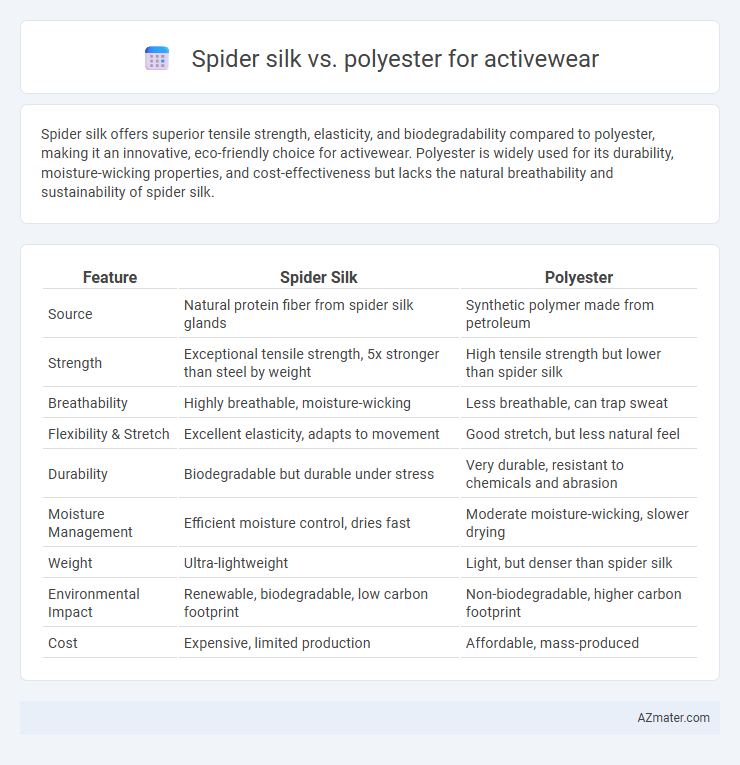Spider silk offers superior tensile strength, elasticity, and biodegradability compared to polyester, making it an innovative, eco-friendly choice for activewear. Polyester is widely used for its durability, moisture-wicking properties, and cost-effectiveness but lacks the natural breathability and sustainability of spider silk.
Table of Comparison
| Feature | Spider Silk | Polyester |
|---|---|---|
| Source | Natural protein fiber from spider silk glands | Synthetic polymer made from petroleum |
| Strength | Exceptional tensile strength, 5x stronger than steel by weight | High tensile strength but lower than spider silk |
| Breathability | Highly breathable, moisture-wicking | Less breathable, can trap sweat |
| Flexibility & Stretch | Excellent elasticity, adapts to movement | Good stretch, but less natural feel |
| Durability | Biodegradable but durable under stress | Very durable, resistant to chemicals and abrasion |
| Moisture Management | Efficient moisture control, dries fast | Moderate moisture-wicking, slower drying |
| Weight | Ultra-lightweight | Light, but denser than spider silk |
| Environmental Impact | Renewable, biodegradable, low carbon footprint | Non-biodegradable, higher carbon footprint |
| Cost | Expensive, limited production | Affordable, mass-produced |
Introduction to Spider Silk and Polyester in Activewear
Spider silk, renowned for its exceptional strength, elasticity, and lightweight properties, offers sustainable advantages in activewear by providing natural breathability and moisture-wicking capabilities. Polyester, a widely used synthetic fiber, excels in durability, quick-drying performance, and resistance to shrinking or stretching, making it a practical choice for high-intensity activities. Comparing these materials highlights spider silk's eco-friendly innovation against polyester's established performance benefits in athletic apparel.
Properties and Composition of Spider Silk
Spider silk's protein-based composition offers exceptional tensile strength, elasticity, and lightweight breathability, making it highly suitable for activewear demanding flexibility and durability. Unlike polyester, which is derived from synthetic polymers, spider silk provides natural moisture-wicking and temperature regulation due to its unique molecular structure. These properties enable enhanced comfort and performance during physical activity, setting spider silk apart as an advanced material in activewear technology.
Polyester: The Synthetic Staple in Activewear
Polyester remains the synthetic staple in activewear due to its durability, moisture-wicking properties, and quick-drying capabilities, making it ideal for high-intensity workouts. This polymer fabric provides excellent elasticity and resistance to shrinking and wrinkles, offering long-lasting performance and shape retention. Its affordability and wide range of finishes further amplify polyester's dominance over natural fibers like spider silk in mainstream activewear markets.
Strength and Durability: Spider Silk vs Polyester
Spider silk exhibits exceptional tensile strength, often outperforming polyester by 5 times in strength-to-weight ratio, making it incredibly resilient under stress. Polyester, while less strong than spider silk, offers reliable durability with high resistance to abrasion, UV light, and moisture, sustaining performance over prolonged use. The superior strength of spider silk combined with polyester's durability makes both materials advantageous for activewear, depending on the required balance between flexibility and toughness.
Moisture Wicking and Breathability Comparison
Spider silk offers superior moisture-wicking properties compared to polyester, effectively pulling sweat away from the skin and promoting faster evaporation to keep the wearer dry during intense activities. Its natural breathable structure allows better air circulation, reducing heat buildup and enhancing overall comfort in activewear. Polyester, while durable and lightweight, tends to trap moisture and heat, making spider silk a more advanced material for performance-focused moisture management and breathability.
Comfort and Feel: Natural vs Synthetic Performance
Spider silk offers unparalleled softness and breathability, making it an exceptional choice for activewear that prioritizes comfort and natural moisture-wicking properties. Polyester, a synthetic fabric, excels in durability and moisture management but often lacks the silky smooth feel and hypoallergenic qualities inherent to spider silk. The natural elasticity and lightweight nature of spider silk enhance wearability, while polyester's resilient fibers provide consistent performance under rigorous activity.
Sustainability and Environmental Impact
Spider silk outperforms polyester in sustainability, being biodegradable and produced through bioengineered processes that reduce reliance on fossil fuels. Polyester, derived from petroleum, contributes significantly to microplastic pollution and has a higher carbon footprint due to energy-intensive manufacturing. The environmental impact of spider silk activewear is minimal, making it a superior eco-friendly alternative to synthetic polyester fabrics.
Cost and Scalability for Mass Production
Spider silk offers exceptional strength and breathability but remains prohibitively expensive and difficult to produce at scale due to complex biotechnological manufacturing processes. Polyester, widely used in activewear, boasts low-cost production and highly scalable manufacturing through established synthetic fiber technologies, making it the dominant choice for mass-market activewear. The cost-effectiveness and scalability of polyester currently outpace spider silk, limiting the latter's application primarily to niche, high-performance athletic gear.
Innovation and Future Potential in Sports Apparel
Spider silk outperforms polyester in sports apparel innovation due to its exceptional strength-to-weight ratio, biodegradability, and natural elasticity. Advanced bioengineering techniques now enable scalable spider silk production, paving the way for sustainable, high-performance activewear that enhances athletic comfort and durability. Future developments focus on integrating spider silk fibers with smart textiles to create responsive, moisture-wicking, and temperature-regulating gear tailored for elite sports performance.
Which Material Reigns Supreme for Activewear?
Spider silk outperforms polyester in activewear due to its exceptional strength-to-weight ratio, natural elasticity, and superior moisture-wicking properties, providing enhanced comfort and durability during intense physical activities. Polyester remains popular for its affordability, quick-drying ability, and resistance to shrinking, but falls short in breathability and environmental impact compared to spider silk's biodegradability and hypoallergenic nature. For athletes seeking performance and sustainability, spider silk reigns supreme as the advanced material of choice in activewear innovation.

Infographic: Spider silk vs Polyester for Activewear
 azmater.com
azmater.com